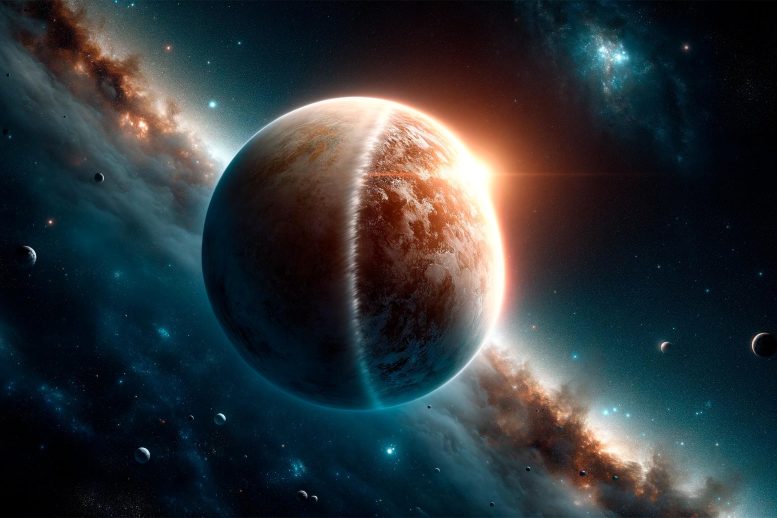
Researchers using data from the Kepler Space Telescope have found that some exoplanets are shrinking due to loss of their atmospheres, likely caused by radiation from their cores. This discovery helps explain the observed size gap in exoplanets and indicates a significant atmospheric loss process different from the previously theorized photoevaporation.
A new study could explain the ‘missing’ exoplanets between super-Earths and sub-Neptunes.
Some exoplanets seem to be losing their atmospheres and shrinking. In a new study using NASA’s retired Kepler Space Telescope, astronomers find evidence of a possible cause: The cores of these planets are pushing away their atmospheres from the inside out.
The Exoplanet Size Gap
Exoplanets (planets outside our solar system) come in a variety of sizes, from small, rocky planets to colossal gas giants. In the middle lie rocky super-Earths and larger sub-Neptunes with puffy atmospheres. But there’s a conspicuous absence – a “size gap” – of planets that fall between 1.5 to 2 times the size of Earth (or in between super-Earths and sub-Neptunes) that scientists have been working to better understand.
“Scientists have now confirmed the detection of over 5,000 exoplanets, but there are fewer planets than expected with a diameter between 1.5 and 2 times that of Earth,” said Caltech/IPAC research scientist Jessie Christiansen, science lead for the NASA Exoplanet Archive and lead author of the new study in The Astronomical Journal. “Exoplanet scientists have enough data now to say that this gap is not a fluke. There’s something going on that impedes planets from reaching and/or staying at this size.”
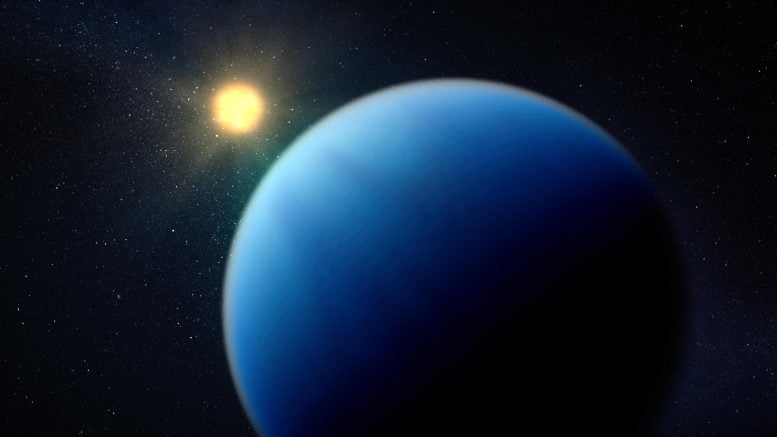
This artist’s concept shows what the sub-Neptune exoplanet TOI-421 b might look like. In a new study, scientists have found new evidence suggesting how these types of planets can lose their atmospheres. Credit: NASA, ESA, CSA, and D. Player (STScI)
Researchers think that this gap could be explained by certain sub-Neptunes losing their atmospheres over time. This loss would happen if the planet doesn’t have enough mass, and therefore gravitational force, to hold onto its atmosphere. So sub-Neptunes that aren’t massive enough would shrink to about the size of super-Earths, leaving the gap between the two sizes of planets.
But exactly how these planets are losing their atmospheres has remained a mystery. Scientists have settled on two likely mechanisms: One is called core-powered mass loss; and the other, photoevaporation. The study has uncovered new evidence supporting the first.
This video explains the differences between the main types of exoplanets, or planets outside our solar system. Credit: NASA/JPL-Caltech
Solving the Mystery
Core-powered mass loss occurs when radiation emitted from a planet’s hot core pushes the atmosphere away from the planet over time, “and that radiation is pushing on the atmosphere from underneath,” Christiansen said.
The other leading explanation for the planetary gap, photoevaporation, happens when a planet’s atmosphere is essentially blown away by the hot radiation of its host star. In this scenario, “the high-energy radiation from the star is acting like a hair dryer on an ice cube,” she said.
While photoevaporation is thought to occur during a planet’s first 100 million years, core-powered mass loss is thought to happen much later – closer to 1 billion years into a planet’s life. But with either mechanism, “if you don’t have enough mass, you can’t hold on, and you lose your atmosphere and shrink down,” Christiansen added.
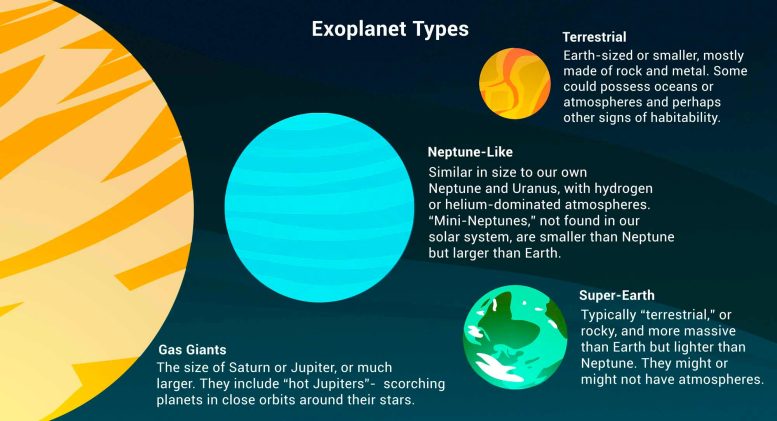
This infographic details the main types of exoplanets. Scientists have been working to better understand the “size gap,” or conspicuous absence, of planets that fall between super-Earths and sub-Neptunes. Credit: NASA/JPL-Caltech
Uncovering Evidence Through Observation
For this study, Chistiansen and her co-authors used data from NASA’s K2, an extended mission of the Kepler Space Telescope, to look at the star clusters Praesepe and Hyades, which are 600 million to 800 million years old. Because planets are generally thought to be the same age as their host star, the sub-Neptunes in this system would be past the age where photoevaporation could have taken place but not old enough to have experienced core-powered mass loss.
So if the team saw that there were a lot of sub-Neptunes in Praesepe and Hyades (as compared to older stars in other clusters), they could conclude that photoevaporation hadn’t taken place. In that case, core-powered mass loss would be the most likely explanation of what happens to less massive sub-Neptunes over time.
In observing Praesepe and Hyades, the researchers found that nearly 100% of stars in these clusters still have a sub-Neptune planet or planet candidate in their orbit. Judging from the size of these planets, the researchers think they have retained their atmospheres.
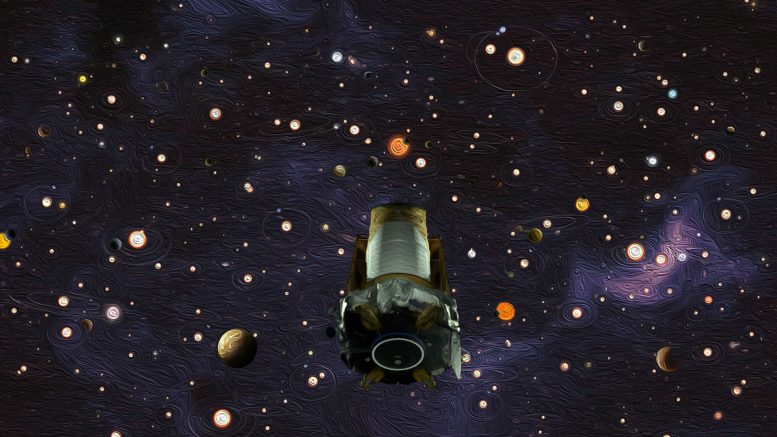
This illustration depicts NASA’s exoplanet hunter, the Kepler space telescope. The agency announced on October 30, 2018, that Kepler ran out of fuel and was being retired within its current and safe orbit, away from Earth. Kepler left a legacy of more than 2,600 exoplanet discoveries. Credit: NASA/Wendy Stenzel/Daniel Rutter
This differs from the other, older stars observed by K2 (stars more than 800 million years old), only 25% of which have orbiting sub-Neptunes. The older age of these stars is closer to the timeframe in which core-powered mass loss is thought to take place.
From these observations, the team concluded that photoevaporation could not have taken place in Praesepe and Hyades. If it had, it would have occurred hundreds of millions of years earlier, and these planets would have little, if any, atmosphere left. This leaves core-powered mass loss as the leading explanation for what likely happens to the atmospheres of these planets.
Ongoing Research and Kepler’s Legacy
Christiansen’s team spent more than five years building the planet candidate catalog necessary for the study. But the research is far from complete, she said, and it is possible that the current understanding of photoevaporation and/or core-powered mass loss could evolve. The findings will likely be put to the test by future studies before anyone can declare the mystery of this planetary gap solved once and for all.
This study was conducted using the NASA Exoplanet Archive, which is operated by Caltech in Pasadena under contract with NASA as part of the Exoplanet Exploration Program, which is located at NASA’s Jet Propulsion Laboratory in Southern California. JPL is a division of Caltech.
Reference: “Scaling K2. VII. Evidence For a High Occurrence Rate of Hot Sub-Neptunes at Intermediate Ages” by Jessie L. Christiansen, Jon K. Zink, Kevin K. Hardegree-Ullman, Rachel B. Fernandes, Philip F. Hopkins, Luisa M. Rebull, Kiersten M. Boley, Galen J. Bergsten and Sakhee Bhure, 15 November 2023, The Astronomical Journal.
DOI: 10.3847/1538-3881/acf9f9
NASA’s Kepler Mission
On October 30, 2018, Kepler ran out of fuel and ended its mission after nine years, during which it discovered more than 2,600 confirmed planets around other stars along with thousands of additional candidates astronomers are working to confirm.
NASA’s Ames Research Center in Silicon Valley, California, manages the Kepler and K2 missions for NASA’s Science Mission Directorate. JPL managed Kepler mission development. Ball Aerospace & Technologies Corporation operated the flight system with support from the Laboratory for Atmospheric and Space Physics at the University of Colorado in Boulder.







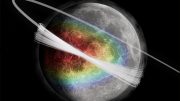

There is a dawn, the sun, the mother of time, is rising, the end of the star, the mother of the world, I was always sad in my life, I lacked you, I kept you in my heart, I gave youmywhole life.A face of a fragrant flower.It has been many years since I did not sleep at night and I thought that God sent me, who is the greatest writer of Iran, about the destruction of life on earth for 12 years, andI became aware of the secrets of the earth.We are facing another system where the Sun is located in a branch in the arm of the galaxy.Now the sun, after the passage of time., about a hundred million years in the last momentsof time, collision with a star in the large arm.is the Milky Way, but our solar system will hit the branch arm of the Milky Way in a thousand years, and the position of the Sun is on the other side of the Milky Wayarm.The distance between the Sun and the nearest star, Alpha Centauri.It is about 40 trillion kilometers away from Earth.There is a possibility of that star colliding with the solar system because there are many solar objects in our system, this is dueto collisions with the arm of the galaxy and there is a possibility of the said star colliding with large planets such as Neptune,Uranus, Saturn or Jupiter.I said that life on Earth will not be destroyed if it collides.Gas planets like Saturn andJupiter collided with other stars in the Milky Way for billions of years, but those stars were hundreds of times smaller than the Sun.If they were bigger or one tenth of the sun, the earth would be hot and there would be no life on it.Hundreds of stars collided with gas planets such as Saturn, Jupiter, and the Sun, and hydrogen gas in Jupiter from the collision.The last star burned and Jupiter continues to burn and moves faster than Earth and Mars.When small stars collide with gasplanets like Jupiter, Neptune, Uranus, Saturn, Jupiter rotate faster than Mars and Earth.All the planets that have hydrogen gas are four in number, which rotate earlier than 24 hours.I know the reason for this is because of the collision of hundredsof stars.It is so small that they rotate earlier than 24 hours.Look at the two gears that are connected to each other.If they do not rotate oppositely, they do not rotate.The opposite star of the planet rotates when it hits thesurface of the planet.The planet Jupiter rotates at a speed of 45,000 km, while the Earth is closer to the Sun, why does it rotate 25 times slower than the planets Uranus, Saturn and Jupiter?Accept that it was due to the impact ofsmall stars that hit these planets from the arm of the galaxy, why did it hit the Earth and Mars?They didn’t because the gravity of the earth is less than that of Saturn and Jupiter.If some words are moved and you notice thatthe sentence is broken, let me know so that I can correct the dictation of the text and send it to you again.This problem is caused by Google translation.My mobiles send a short message Mehrdad 00989332197646 and I will respond to any question.Myemail is not working.Doctor of Astronomy, Religions, Poet and Writer from Iran, may God protect you. god by thank you
Hello sir namaste god bless all family memberweareprayer for alls